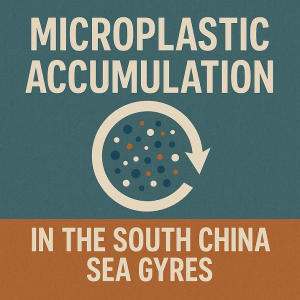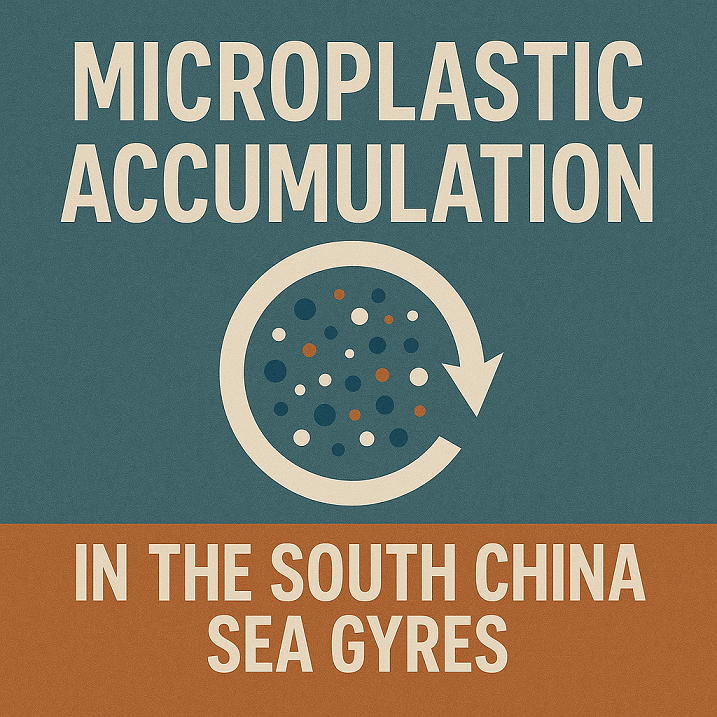Microplastic accumulation in the South China Sea gyres is reaching critical levels, threatening marine life, coastal economies, and global seafood safety. Dive into the science, real-world data, and regional solutions tackling this hidden crisis.
Why Microplastic Pollution in the South China Sea Matters
 The South China Sea, a marine artery of global trade and biodiversity, is facing an escalating crisis. While oil spills and overfishing grab headlines, a quieter threat is swirling below the surface: microplastic pollution. These tiny plastic fragments—less than 5mm in size—are accumulating in the gyres (rotating ocean currents) of the South China Sea, forming invisible but dangerous clouds of synthetic waste.
The South China Sea, a marine artery of global trade and biodiversity, is facing an escalating crisis. While oil spills and overfishing grab headlines, a quieter threat is swirling below the surface: microplastic pollution. These tiny plastic fragments—less than 5mm in size—are accumulating in the gyres (rotating ocean currents) of the South China Sea, forming invisible but dangerous clouds of synthetic waste.
What makes this particularly alarming is that the South China Sea is not just a biodiversity hotspot. It also supports over 3.5 billion USD worth of annual seafood exports, according to UNCTAD (2023), and serves as a maritime crossroads for tankers and trawlers. As microplastics infiltrate the food web, their impacts reach both local fishing communities and global consumers.
The IMO, UNEP, and regional maritime authorities have called for urgent intervention. But fragmented governance, uneven enforcement, and rising coastal plastic use have hindered progress. Understanding how gyres trap microplastics—and what can be done about it—is key to tackling this silent maritime pollutant.
What Are Microplastics and How Do They End Up in Gyres?
Microplastics are fragments of plastic debris that either enter the ocean already small (from products like cosmetics and synthetic clothing fibers) or break down from larger items like bottles, bags, and fishing nets.
Sources of Microplastics in the South China Sea
- Riverine Inputs: The Mekong, Pearl, and Red Rivers are among the most plastic-polluted rivers globally (World Bank, 2023).
- Shipping and Fishing Waste: Lost gear, synthetic ropes, and shipboard litter discharge plastics directly into the sea.
- Tourism and Coastal Cities: Inadequate waste management in coastal hotspots like Manila, Ho Chi Minh City, and Jakarta contributes significantly.
- Atmospheric Deposition: Recent research from Marine Pollution Bulletin (2022) suggests microplastics can even arrive via rainfall.
Why Gyres Are Plastic Traps
Ocean gyres are large-scale systems of circulating currents. In the South China Sea, these gyres—especially one near the northern basin off Vietnam and southern China—act like conveyor belts, concentrating floating plastics into semi-stable patches.
The South China Sea is semi-enclosed and influenced by monsoonal winds, creating complex circulation patterns. These conditions make its gyres uniquely vulnerable to plastic retention, even though they may not be as massive as the infamous Great Pacific Garbage Patch.
Impacts of Microplastic Accumulation in the South China Sea
Harm to Marine Life
Microplastics are often ingested by fish, shellfish, seabirds, and even plankton. The Journal of Marine Science and Engineering (2023) found that over 80% of sampled anchovies and sardines in the northern South China Sea had microplastics in their guts.
Nanoplastics—particles smaller than microplastics—can cross cell membranes, causing inflammation, organ damage, and behavioral changes in fish.
Seafood Safety and Human Health
The South China Sea supplies a significant portion of Asia’s seafood. A 2022 study by Elsevier’s Marine Pollution Bulletin noted that bivalves like mussels and clams act as bioindicators due to their filter-feeding. These species, commonly eaten whole, show high microplastic loads.
While the health effects on humans are still under investigation, early studies suggest links to hormonal disruption, inflammation, and oxidative stress when microplastics are ingested regularly.
Economic Consequences
Microplastics affect the marketability of seafood, reducing consumer trust in regional exports. According to ICS shipping insights (2023), concerns over contaminated fish have led to increased quality checks and delays at European and North American ports.
Tourism is also affected. In areas like Ha Long Bay and Boracay, plastic debris (including microplastics washing ashore) damages brand image and deters eco-tourism.
Ecosystem Disruption
Microplastics can alter sediment chemistry, harm coral reefs, and impact larval development. Researchers at WMU Journal of Maritime Affairs describe a “cascading effect” where changes in microbial and zooplankton populations ripple up the food chain.
Key Technologies and Monitoring Developments
Remote Sensing and Satellite Imaging
While microplastics are too small to be directly detected from space, remote sensing can track plastic-related ocean conditions like chlorophyll concentrations, temperature anomalies, and debris movement. Organizations like MarineTraffic and Lloyd’s List Intelligence assist by mapping shipborne pollution pathways.
Oceanographic Drifters and Buoys
Projects by the IOC-UNESCO, Inmarsat, and ASEAN Centre for Biodiversity deploy drifters to simulate plastic drift, helping researchers understand gyre dynamics.
Microplastic Sensors and AI Detection
Recent developments from RISE of Sweden and Japan’s JAMSTEC use machine learning to analyze microplastic density from water samples collected by autonomous vessels. These innovations are scaling up in the South China Sea via pilot programs led by Hong Kong University of Science and Technology.
Regional Responses and International Cooperation
National Initiatives
- Vietnam launched its National Action Plan on Marine Plastic Waste Management (2020–2030) aiming to reduce ocean plastic leakage by 75% by 2030.
- China’s Yangtze River plastic ban is expected to indirectly reduce plastic loads entering the South China Sea.
- The Philippines’ DENR has partnered with international NGOs to support coastal cleanup and community awareness programs.
ASEAN Marine Debris Action Plan (AMDAP)
This action plan (2021–2025) commits ASEAN member states to:
- Improve monitoring and data sharing
- Reduce single-use plastics
- Promote extended producer responsibility (EPR)
Though implementation is uneven, SEAFDEC and UNEP Asia-Pacific offer technical and funding support.
Port State Measures and IMO Regulations
The IMO’s MARPOL Annex V regulates shipborne plastic discharge. However, a 2022 Paris MoU report revealed that 28% of vessels surveyed in Southeast Asia failed to meet waste handling standards.
NGO-Led Cleanup and Education
Groups like Ocean Conservancy, The Plastic Bank, and Greenpeace Southeast Asia have held high-impact cleanups in Malaysia, the Philippines, and Thailand. These efforts, while localized, help raise awareness and build pressure for legislative reform.
Case Study: The Pearl River Estuary and Lingdingyang Gyre
One of the most studied microplastic hotspots is the Pearl River Estuary, which empties into the Lingdingyang area of the South China Sea. Home to Guangzhou and Shenzhen, this industrial corridor produces enormous volumes of plastic waste.
A 2023 study by the Chinese Academy of Sciences found microplastic concentrations in surface water exceeding 1.2 million particles per square kilometer, among the highest ever recorded in coastal Asia.
Despite being a research focus, governance remains limited. Scientists have recommended the establishment of an Urban-Estuarine Microplastic Task Force, but no formal body exists yet.
Future Outlook: Can the South China Sea Gyres Recover?
Biodegradable Alternatives and EPR Policies
Governments are gradually pushing manufacturers toward biodegradable polymers and reusable designs. Indonesia’s 2025 plastic roadmap includes a mandatory EPR policy for consumer goods companies, setting a strong precedent.
However, degradable plastics are not a silver bullet—they require specific conditions to break down and may still release toxic compounds.
Enhanced Regional Governance
Calls are growing for a South China Sea Environmental Monitoring and Cleanup Consortium, modeled after the Baltic Sea’s HELCOM. Such a body could coordinate:
- Joint gyre monitoring
- Cross-border plastic transport studies
- Public-private cleanup initiatives
Blue Economy Integration
The World Bank promotes integrating marine waste reduction into national Blue Economy frameworks, making clean seas an economic development objective. This helps shift the narrative from “waste management” to “marine sustainability.”
Maritime Education and Industry Engagement
The IMO Model Courses now include marine litter management, encouraging cadets and officers to practice waste segregation. Maritime academies in the region—like Massachusetts Maritime Academy and Maritime Knowledge India—also integrate plastic awareness into navigation and engine room training.
Frequently Asked Questions (FAQ)
What are microplastics and how do they get into the ocean?
Microplastics are plastic particles smaller than 5mm that come from product use, industrial waste, or the breakdown of larger plastics. They enter the ocean via rivers, coastlines, ships, and even rainfall.
Why are gyres hotspots for microplastic accumulation?
Ocean gyres are slow-moving current systems that trap floating debris, including microplastics, which then accumulate over time.
Are microplastics harmful to humans?
While research is ongoing, early studies suggest health risks linked to ingestion through seafood, including hormone disruption and inflammation.
What is being done in the South China Sea region?
Initiatives include national plastic bans, ASEAN cooperation, port inspections, cleanups, and emerging tech like AI-driven sensors.
Can we clean up the microplastics already in gyres?
Not easily. Microplastics are dispersed and tiny, making collection costly and complex. Prevention is currently more effective than removal.
Is there any hope for reversing this trend?
Yes—through stronger regulation, education, innovation, and international cooperation, progress is possible. But urgency is key.
Conclusion
The South China Sea gyres are becoming microplastic time bombs—ticking quietly beneath the waves. Unlike oil spills or red tides, the threat is subtle but pervasive. Yet, the solution is not only possible; it’s already underway in patches across the region.
Governments, industry, scientists, and citizens must work together to stem the tide. By turning attention to microplastic gyre accumulation today, we may still preserve tomorrow’s marine biodiversity, seafood security, and maritime economy.
References
- UNCTAD. (2023). Blue Economy and Marine Plastic Pollution. https://unctad.org/publication/blue-economy-marine-plastic-pollution
- World Bank. (2023). Plastic Waste in Asian Rivers. https://www.worldbank.org/en/news/feature/2023/06/05/plastic-pollution-in-southeast-asia
- Marine Pollution Bulletin. (2022). Microplastic loads in bivalves. https://www.sciencedirect.com/journal/marine-pollution-bulletin
- WMU Journal of Maritime Affairs. https://link.springer.com/journal/13437
- Journal of Marine Science and Engineering. (2023). Microplastic ingestion in anchovies. https://www.mdpi.com/journal/jmse
- IMO. (2023). MARPOL Annex V Overview. https://www.imo.org/en/OurWork/Environment/Pages/Default.aspx
- Paris MoU. (2022). Ship Waste Compliance Report. https://www.parismou.org
- ASEAN Secretariat. (2021). Marine Debris Action Plan. https://asean.org/book/asean-regional-action-plan-on-combatting-marine-debris-in-the-asean-member-states-2021-2025/
- Greenpeace Southeast Asia. https://www.greenpeace.org/southeastasia/
- Ocean Conservancy. https://oceanconservancy.org

